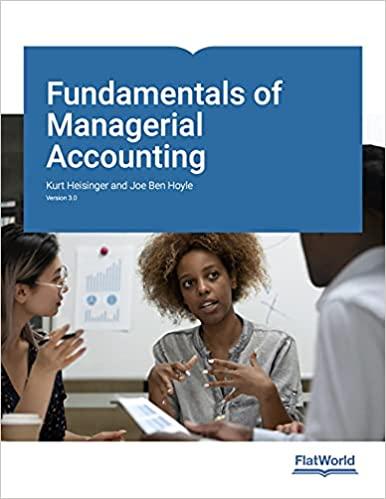Question
The Hudson Bay Cake Company makes cakes for large grocery store chains. It uses a process costing system to cost the production of its cakes.
The Hudson Bay Cake Company makes cakes for large grocery store chains. It uses a process costing system to cost the production of its cakes. The cakes are made in two departments: Mixing and Baking. In the Mixing department the direct ingredients are added when 25% of the production has taken place. This gives the production team time to thoroughly clean the mixing vats before adding ingredients. Conversion costs are added evenly throughout the process.
The cost accountant is completing the production report for the month of July. At the beginning of the month there were 3,500 cakes that had 30% of the work completed in June. 19,000 cakes were started in the month of July and 2,500 cakes remain in ending inventory at the end of July. These cakes are 50% complete. The rest were completed and transferred to the Baking Department.
The cost accountant must determine how much of the following costs should be transferred to the Baking Department and how much remains in ending inventory at the end of July.
Cost of beginning work-in-process:
- Direct ingredients $ 6,125
- Conversion costs $ 1,029
Cost added during July:
- Direct ingredients $29,640
- Conversion costs $18,180
Required:
- Using the first-in, first-out (FIFO) method determine the assignment of the cost of cakes transferred-out to Baking and ending inventory for the Mixing department for the month of July. Use the form on the next page of this exam. (10 marks)
- The Hudson Bay Cake Company has used First in First out costing for the last 15 years. The controller wants to know if it is beneficial to continue using this method instead of the weighted average method. Provide the controller with your recommendation. Include appropriate calculations to back up your recommendation. (4 marks)
| STEP 1: Units to be accounted for: | Quantity Schedule | Production report | |
| Work in process, beginning |
| ||
| Started into production |
| ||
| Total units |
| ||
|
|
| Equivalent units | |
| Units accounted for: |
| Ingredients | Conversion |
|
|
|
|
|
|
|
|
|
|
|
|
|
|
|
|
|
|
|
|
| STEP 2: Cost to be accounted for: | Total Prod. Costs | Total costs | |
| Ingredients | Conversion | ||
|
|
|
|
|
|
|
|
|
|
|
|
|
|
|
|
|
|
|
|
| Total cost (a) |
|
|
|
|
|
|
|
|
| Equivalent units of production (b) (Step 1 above) |
|
|
|
| Cost per equivalent unit (a / b) |
|
|
|
|
|
|
|
|
| STEP 3: Cost Reconciliation |
| Equivalent units | |
| Ingredients | Conversion | ||
|
|
|
|
|
|
|
|
|
|
|
|
|
|
|
| Total cost of goods completed |
|
|
|
|
|
|
|
|
|
|
|
|
|
| Total ending work in process |
|
|
|
| Total cost |
|
|
|
Step by Step Solution
There are 3 Steps involved in it
Step: 1

Get Instant Access to Expert-Tailored Solutions
See step-by-step solutions with expert insights and AI powered tools for academic success
Step: 2

Step: 3

Ace Your Homework with AI
Get the answers you need in no time with our AI-driven, step-by-step assistance
Get Started


